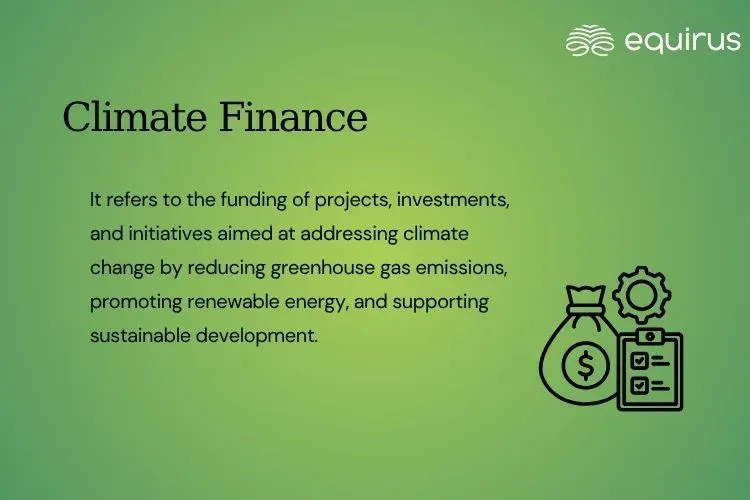Climate Finance

Key Highlights
-
Climate Finance refers to the funding of projects, investments, and initiatives aimed at addressing climate change by reducing greenhouse gas emissions, promoting renewable energy, and supporting sustainable development.
-
Key components includes green bonds & climate bonds, sustainable investments, carbon financing and public-private partnerships.
What is Climate Finance?
Climate Finance refers to the funding of projects, investments, and initiatives aimed at addressing climate change by reducing greenhouse gas emissions, promoting renewable energy, and supporting sustainable development. It involves capital flows from public, private, and multilateral sources to facilitate a transition to a low-carbon economy, while generating environmental and financial returns.
Purpose of Climate Finance
-
Sustainable Development: Supports renewable energy, energy efficiency, and climate-resilient infrastructure.
-
Risk Mitigation: Helps investors and institutions manage long-term environmental and regulatory risks.
-
Policy Alignment: Encourages investment strategies aligned with global climate goals.
-
Market Incentives: Mobilizes capital toward environmentally sustainable projects and green technologies.
Key Components
-
Green Bonds & Climate Bonds: Debt instruments specifically raised for environmentally sustainable projects.
-
Sustainable Investments: Equities, private equity, and infrastructure projects with climate-positive impacts.
-
Carbon Financing: Investments linked to carbon credits, offsets, or emissions reduction projects.
-
Public-Private Partnerships: Collaborative funding between governments, institutions, and private investors.
Applications in Capital Markets
-
Institutional Portfolios: Allocation of funds to green bonds, ESG-compliant funds, and climate-focused assets.
-
Investment Banking: Structuring and underwriting green financing instruments for corporates and projects.
-
Alternative Investments: Funding renewable energy projects, sustainable real estate, and cleantech ventures.
-
Risk Management: Incorporating climate-related financial risks into investment strategies.
Benefits of Climate Finance
-
Alignment with ESG Goals: Supports environmentally responsible investment strategies.
-
Diversification: Access to emerging markets and sustainable sectors.
-
Long-Term Value Creation: Potential for stable returns from infrastructure and renewable energy investments.
-
Regulatory Compliance: Meets growing mandates and guidelines for ESG and climate-related disclosures.
Risks & Considerations
-
Market & Regulatory Risk: Changes in policy or incentives can impact returns.
-
Project Risk: Renewable and infrastructure projects may face execution or operational challenges.
-
Measurement & Reporting: Impact measurement can be complex and may vary across frameworks.
-
Liquidity Constraints: Some climate-focused investments may be less liquid than traditional securities.
